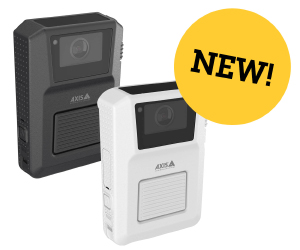Retail Environment
The Halo Effect
Body of Evidence Supports the Rise of Body Worn Cameras in Front-Line Retail
When we talk about the so-called “halo effect” in relation to loss prevention, we are describing what criminologist Emeritus Professor Adrian Beck refers to as “the diffusion of benefit”, when a technology used in a specific area of retail to prevent shoplifting, for example, creates a wider perception of security for the store and a heightened sense of jeopardy for the perpetrators.
The term “halo effect” was originally used as a term in relation to EAS tagging, where an item did not appear to be protected, but in reality, a security label was integrated into the fabric of the item and would activate the EAS gates upon exit. The reality was that only certain high-end apparel items were tagged, leaving the rest on the rail vulnerable, but the thief did not know that or, if suspicious, did not want to take the risk.
In that respect, it’s a perfect lower-cost crime prevention tool which, rather like a placebo, may be the real deal or simply a dummy, but in the mind of the store thief creates a sense of doubt which in turn triggers a change in behaviour because the halo effect from that one tag emanates outwards and creates the perception of security or benefit to the whole store.
We still talk about the halo effect today, and Professor Beck references the diffusion of benefit in relation to the new and emerging technology of body worn cameras (BWC) in his latest Axon-sponsored research entitled “Body Worn Cameras in Retail, a review of use and impact”.
Although not quite ubiquitous in the retail space, the adoption of the technology in the UK has been rapid in deployment compared to other parts of the world in direct response to the increasing levels of violence and aggression levelled at security officers and store colleagues.
The benefits of the technology have been felt outside of retail in what Professor Beck refers to as a “mass transit context” at its efficacy in and around train stations. In one report, statistics revealed that levels of violence and aggression fell dramatically—by 47 per cent—on and around the platforms. But the study revealed the diffusion of benefit effect in other parts of the station as well, even though there were no BWC’s in use.
History
Introduced in 2005 as a small-scale trial by Devon and Cornwall Police, the first significant deployments of body worn cameras at national level were undertaken by the Police Standards Unit (PSU) as part of the Domestic Violence Enforcement Campaign (DVEC) in 2006.
The basic command units equipped with the head cameras recorded everything that happened during an incident from the time of arrival which led to the “preservation of good-quality first disclosure evidence from the victim”. The evidence gathered was deemed especially useful in the way of supporting prosecutions if the victim was reluctant to give evidence or press charges.
This led the Home Office to publish a report stating that “evidence gathering using this equipment has the potential to radically enhance the police performance at the scene of a wide range of incidents”.
In the same report, the Home Office concluded that the BWC system used in Devon and Cornwall had “the ability to significantly improve the quality of the evidence provided by police officers at incidents”.
By July 2007, the Home Office was beginning to encourage the emerging industry and published another document entitled “Guidance for the Police use of Body Worn Cameras”.
The report was based on the first national pilot of body worn cameras conducted in Plymouth. Tony McNulty MP, the Minister of State for Security, Counter Terrorism, and Police wrote the foreword that held the emerging technology in a promising light: “The use of body-worn video has the potential to improve significantly the quality of evidence provided by police officers…video recording from the scene of an incident will capture compelling evidence…that could never be captured in written statements”.
Despite being hailed as a tool to enhance the quality of evidence, the focus was beginning to shift away from exclusively benefiting prosecutions. The Home Office highlighted that body worn cameras also had the significant potential to “prevent and deter crime”.
In addition, the final report on the National Pilot for BWC announced that complaints against the officers wearing the cameras had been reduced to zero, and time spent on paperwork had been reduced by 22.4 per cent, which led to a 9.2 per cent increase in officer time spent on patrol (50 minutes of a nine-hour shift).
In 2010, over forty UK police force areas were using body cameras to varying degrees. Grampian Police were one such force that initiated a trial in July 2010 which paved the way for the Paisley and Aberdeen body worn camera project in 2011 which was considered a huge success, and it was identified that the benefits saved an estimated minimum of £400,000 per year as a result of increased public reassurance, reduced fear of crime in local communities, an increase in early guilty pleas, faster resolution of complaints against police officers, and reduced assaults on officers.
Retail
The growing deployment of body worn cameras in policing opened the door to the technology in other environments, such as frontline emergency service personnel including fire officers and paramedics and rail companies, but it took the best part of a decade for BWCs to be widely deployed in the retail sector, with Lidl GB becoming the first supermarket to roll the technology out across all its 900+ stores as standard, as part of a £2 million investment.
The 2024 BRC Crime Survey revealed a doubling in the value of retail theft to almost £2 billion, and a major spike in violent incidents from eight-hundred-and-seventy to 1,300 per day.
At the same time, the BRC figures revealed woeful police response times, with 44 per cent of retailers in its annual crime survey rating police response as “poor” or “very poor”. For one major retailer, the police’s own data shows that they failed to respond to 73 per cent of serious retail crimes that were reported.
This picture is compounded by the fact that the retail industry spent £3.3 billion on measures to reduce retail crime, almost double what it spent the previous year. BWC’s played a role in that increased spend as retailers looked for demonstrable solutions to make colleagues feel safer at work.
In what has become the first major study into BWCs, Professor Beck’s “Body Worn Cameras in Retail, a review of use and impact” research published in July 2024 provides a detailed review of how a technology—typically associated with law enforcement—is being used by retailers and what impact, if any, it is having.
Based upon in-depth interviews with representatives from sixteen large retail organisations that have been using body worn cameras for a period—some for several years across multiple locations, others just completing a time-limited trial in a few stores—the retailers who have taken part in this study operate in Australia, New Zealand, the UK, and the USA.
According to the findings, one of the key takeaways was that all participating retailers were positive about the contribution BWC’s had made as part of their overall approach to making their stores safer and less prone to crime.
Eight of the 16 retailers provided indicative data showing a reduction in the number of incidents of violence and verbal abuse of about 37 per cent.
One respondent offered data showing that 45 per cent of the time a situation was de-escalated because of turning on the BWC’s. Across all the other respondents, positive impacts on de-escalation were based upon anecdotal evidence from users describing how incidents had significantly changed—for the good—when BWC’s were activated.
Of the 114 activations among those retail businesses taking part in the study, 47 per cent of the incidents resulted in a de-escalation as a result of the use of BWC and, importantly, there had been zero complaints from the public about the use of the technology.
Feedback was overwhelmingly positive about the impact of BWC’s on wearers’ perceived safety and security. Various surveys of retail staff suggested that as many as 66-to-80 per cent of staff felt safer because of the introduction of BWC’s.
Professor Beck said BWC’s provide a way to increase the “dosage” of video technologies. Existing CCTV is typically low dosage because it is largely invisible to the customer, where BWC is far more “in your face”.
Public display monitors such as those on self-checkouts where customers know they are being watched, adds to the higher dosage levels.
“In general, people feel safer under the gaze of cameras,” said Professor Beck.
“Body worn cameras have the effect of moderating behaviour and act as a tension diffuser, but they also have the capacity to record audio so we can hear what’s going on which adds an extra dimension.”
He said return on investment was difficult to measure because of the prevalent view that “you simply can’t put a price on the safety of your staff”, and the acceptance of the introduction of BWC by the businesses was easier to explain in terms of the recent widespread media exposure around violence and aggression targeting store colleagues.
There were some key points in the research around the colleague interaction with the technology, particularly “wearability” in terms of size, weight, and attachment to uniforms.
“The fact of the matter is that if they are too heavy and cumbersome staff will not wear them,” he said.
Morrisons Daily
The halo effect and the wearability challenge were key issues for Morrisons Daily, the convenience offering of the UK’s fourth largest supermarket which has more than 1,500 stores across the UK. The halo effect in this instance refers to HALO Technologies, the provider of the robust and compact BWC’s used by store colleagues.
“Every month our directors take questions on colleague safety, so it is something that we as a business have been talking about for a long time in light of the heightened levels of violence our colleagues have experienced,” said James Coomber, Morrisons’ regional technical manager for the South East.
“Alongside other retailers, we have been experiencing a number of serious violent incidents where prolific offenders often re-offend following release from prison. In a recent case we were able to utilise the BWC video and secure a recall to prison with the police.”
“General CCTV in stores is useful, but it does not capture what a colleague sees, and it is certainly not able to provide audio and instantaneous support to colleagues.”
So, the business reviewed a number of different BWC providers before settling on the HALO Bodycam solution.
“We did some pre-trials at high-risk stores with HALO so that they could understand the challenges and confidence levels of the colleagues on the front-line who have experienced significant levels of crime. These trials have proved invaluable because our monitored feedback has shown higher levels of confidence from the staff since they were introduced,” he continued.
“They like it because of the de-escalation benefit of it—the offender looks directly into the camera, and they know they are being recorded which can change their behaviour.”
“They are completely different to other body worn cameras in that they are half the size, easy to wear and carry,” he said.
“The feedback we’ve had from colleagues is that they are discreet, and they don’t get in the way because they are like a Go-Pro and smaller than a credit card.”
“It is also easier to use and less clunky than other BWC’s on the market. Building cases is much easier because staff don’t have to dock to send information. They are operated off a 4G hub.”
The HALO model differs from the industry standard in that instead of buying a camera and licences, it operates off a monthly subscription model rental agreement in the same way as a mobile phone contract. And rather than having to dock the device to charge and send data, it has the capacity to offload the footage through the 4G network which not only minimises the workload of the operative, but also saves valuable time when reporting an incident.
It’s unique quad core processing facilitates recording, live streaming, GPS, and two-way communication and AI simultaneously.
“HALO was also able to integrate the technology into our security operations centre (SOC) in Corby so operatives there get live footage which they can use to immediately contact the police—it’s real-time access.”
HALO
James praises the proactivity of Halo in helping to create a bespoke technological solution for the fast-paced convenience market where small footprint stores can literally bring colleagues face-to-face with prolific and persistent offenders as well as angry and frustrated customers.
Matt Nesbitt, the co-founder and global partnerships director at HALO, said: “We trade in time and technology.”
According to HALO, the time savings of not having to dock the device in a busy store is often estimated to be around fifteen minutes per camera, per day. Based on an example of two hundred cameras across an estate, that equates to fifty hours per day, or 18,250 hours per year.
“If you look at this through the eyes of the extra productivity of someone earning £13 per hour, the business would be close to £240,000 per year,” said Matt.
“As a business that is primarily focused on the private sector, we are trying to be different by offering the best solutions at the best prices,” he added.
Based in Northern Ireland but with offices in the US and the Republic of Ireland, Matt has seen the business grow exponentially since it was established in 2020. Staff numbers have more than doubled to seventy in less than a year.
It now boasts 30,000 cameras in the field across twenty-five countries, with an enviable portfolio of 1,400 individual customers, many of whom are household brand names.
“We are one of the fastest growing body worn camera companies in the world,” said Matt who has recently seen HALO fundraise 20 million dollars to back its latest developments.
“We have entered the world of retail after working largely in private security and for train operating companies where there were challenges with aggressive or frustrated passengers—we learned a lot from this market, and it has helped inform the future development of our products.”
“We have strived to make this the highest spec BWC on the market and we have developed a totally automated system that eliminates all human error,” said Matt.
“The quad core processor inside HALO’s flagship device, the HALO Horizon, means it has a big engine under the hood, and the ability to offload through 4G is unique—no one else has this on the market,” said Matt, who left University with a master’s in economics before taking a break to travel.
Having returned from the Middle East he joined another BWC company but left to set up his own business based around technologically disrupting the market and creating longevity of use in terms of its iconic products. Like Apple, HALO invests in a software and hardware upgrade business model so products are constantly augmented to the latest best versions of themselves.
Research and development are also key to HALO’s business growth. The business is now advanced in its quest to deliver multiple new AI features including audio transcription into the technology to further reduce reporting times.
“We are working on this with one of our big retailer customers which is looking to reduce its reporting times. This process could save a staggering 83 hours of productive time across an estimated 300 incidents in the initial delivery alone.”
Apart from the human cost in terms of reducing the likelihood of trauma and absenteeism by thwarting a potentially violent or aggressive encounter, there is also a hard-nosed commercial reality to faster reporting times. Minutes count when it comes to getting evidence collated, and that is time saved for the business in terms of productivity and allowing colleagues to do what they are paid for rather than having to spend time filling in incident reports.
Robust
The HALO devices are also robust in terms of being shock and water-resistant. Matt has kept one of the HALO devices as a sales tool after it was run over by a heavy goods truck. It continued to work and does so to this day despite the cosmetic damage.
The BWC market, while still in its infancy, is making significant in-roads to reducing incidents of violence and aggression through de-escalation, and in doing so is creating a halo and ripple effect on behaviours. The market is set to grow, and the technology is likely to realise its full potential as a repository of vital prosecution evidence when the Criminal Justice Bill finally becomes law during this Parliament, meaning that it will become a separate offence to assault a retail worker.
The industry also recognises that it can’t arrest itself out of a crisis, but the increasingly ubiquitous presence of body worn cameras will create the ultimate halo effect of altering behaviour and reducing the incidents of aggression altogether.






